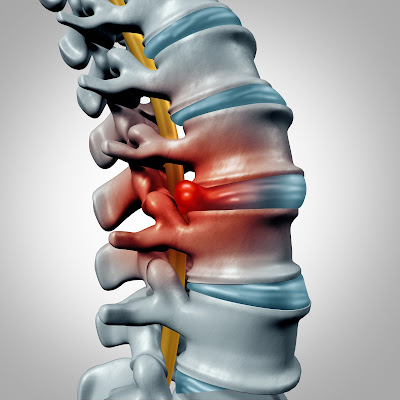Disc herniation or herniated disc is the leaking of soft inner gel in the disc to the spinal canal. This occurs when the disc degenerates. Once inside the spinal canal, the herniated disc material puts pressure on the nerve, causing pain to radiate down the nerve leading to sciatica or leg pain (from a lumbar herniated disc) or arm pain (from a cervical herniated disc).
Few passive treatments involve:
1. Deep Tissue Massage: It uses pressure to relieve the deep muscle tension and spasms, which develop to prevent muscle motion at the affected area.
2. Hot and Cold Therapy: heat may be used to increase blood flow to the target area. Blood helps heal the area by delivering extra oxygen and nutrients. Blood also removes waste byproducts from muscle spasms. Conversely, cold therapy slows circulation. This reduces inflammation, muscle spasms and pain. An ice pack may be placed on the target area, followed by an ice massage, which can be followed by a spray fluoromethane that cools the inflamed tissues.
3. Hydrotherapy: Hydrotherapy may involve sitting in a tub with warm water. It gently relieves pain and relaxes the muscles.
4. Transcutaneous electrical nerve stimulation (TENS): A TENS machine uses an electrical current to stimulate the muscles. Electrodes that are taped to skin send a tiny electrical current to key points on the nerve pathway. This reduces muscle spasms and triggers the release of endorphins, body's natural pain killers.
5. Traction: The goal of traction is to reduce the effects of gravity on the spine. By gently pulling apart the bones, the intent is to reduce the disc herniation.
These physical therapy exercises & techniques help in achieving core stability, flexibility, stress reduction of muscles & also strengthen them.
Few passive treatments involve:
1. Deep Tissue Massage: It uses pressure to relieve the deep muscle tension and spasms, which develop to prevent muscle motion at the affected area.
2. Hot and Cold Therapy: heat may be used to increase blood flow to the target area. Blood helps heal the area by delivering extra oxygen and nutrients. Blood also removes waste byproducts from muscle spasms. Conversely, cold therapy slows circulation. This reduces inflammation, muscle spasms and pain. An ice pack may be placed on the target area, followed by an ice massage, which can be followed by a spray fluoromethane that cools the inflamed tissues.
3. Hydrotherapy: Hydrotherapy may involve sitting in a tub with warm water. It gently relieves pain and relaxes the muscles.
4. Transcutaneous electrical nerve stimulation (TENS): A TENS machine uses an electrical current to stimulate the muscles. Electrodes that are taped to skin send a tiny electrical current to key points on the nerve pathway. This reduces muscle spasms and triggers the release of endorphins, body's natural pain killers.
5. Traction: The goal of traction is to reduce the effects of gravity on the spine. By gently pulling apart the bones, the intent is to reduce the disc herniation.
These physical therapy exercises & techniques help in achieving core stability, flexibility, stress reduction of muscles & also strengthen them.



No comments:
Post a Comment